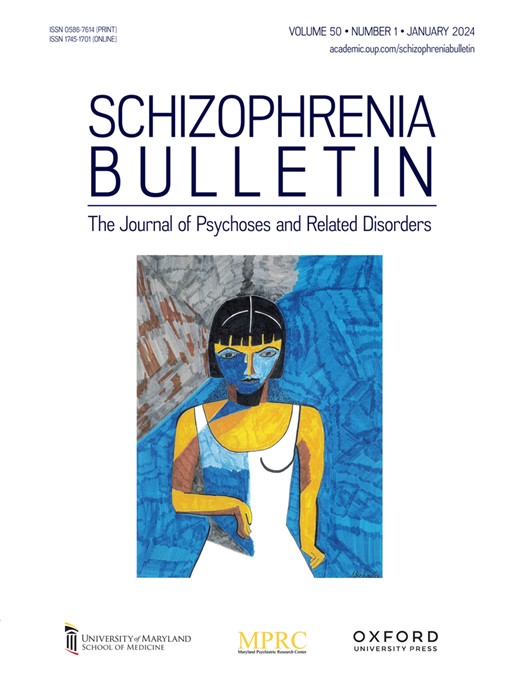与严重精神疾病中身体多病相关的社会心理和人口因素:系统综述
IF 4.8
1区 医学
Q1 PSYCHIATRY
引用次数: 0
摘要
背景与假设患有严重精神疾病(SMI)的人,如精神分裂症和双相情感障碍的预期寿命较短。这主要是由于身体多病(MM),定义为共存的两种或两种以上的身体健康状况。本系统综述确定了哪些社会心理和人口因素与重度精神分裂症中的MM相关。研究设计检索Embase、PubMed和PsychINFO,没有出版日期或研究设计限制。如果研究评估了社会心理和/或人口因素对重度精神分裂症患者MM结局的影响,则有资格纳入研究。30项研究符合本综述的纳入标准。MM的最强预测因子是儿童虐待(比值比[OR]高达8.70 [95% CI 2.49-30.33])、女性(OR高达2.47 [95% CI 1.35-4.50])、年龄较大(OR高达1.60 [95% CI 1.31-1.96])和种族(例如加勒比黑人群体相对于英国白人群体的OR高达2.09 [95% CI 1.81-2.42])。混合证据的预测因子包括受教育程度、就业状况、社会经济地位、婚姻状况、城市化程度、贫困、原籍国、医疗保健获取和全球功能。研究结果强调了可能导致MM的社会心理因素(如儿童虐待)和人口因素(如年龄较大),这具有很强的临床意义。有些因素是可以改变的(例如教育),可以为重度精神疾病中MM的风险预防策略提供信息,减轻过早死亡的风险。未来的研究应该使用一致的MM定义进行交叉研究比较,并评估其他风险因素、它们的相互作用和潜在机制。本文章由计算机程序翻译,如有差异,请以英文原文为准。
Psychosocial and Demographic Factors Associated with Physical Multimorbidity in Severe Mental Illness: A Systematic Review
Background and Hypothesis People with severe mental illness (SMI), such as schizophrenia and bipolar disorder have a reduced life expectancy. This is largely due to physical multimorbidity (MM), defined as the coexistence of two or more physical health conditions. This systematic review identifies which psychosocial and demographic factors are associated with MM in SMI. Study Design Embase, PubMed, and PsychINFO were searched with no limits on publication date or study design. Studies were eligible for inclusion if they assessed the impact of psychosocial and/or demographic factors on MM outcomes among people with SMI. Study Results Thirty studies met the inclusion criteria for this review. The strongest predictors of MM were childhood maltreatment (odds ratios [OR] up to 8.70 [95% CI 2.49-30.33]), female gender (OR up to 2.47 [95% CI 1.35-4.50]), older age (OR up to 1.60 [95% CI 1.31-1.96]), and ethnicity (e.g. OR up to 2.09 [95% CI 1.81-2.42] for Black Caribbean groups relative to White British groups). Predictors with mixed evidence included educational attainment, employment status, socioeconomic status, marital status, urbanicity, deprivation, country of origin, healthcare access, and global functioning. Conclusions The findings highlight psychosocial factors (e.g. childhood maltreatment) and demographic factors (e.g. older age) that may contribute to MM, which has strong clinical implications. Some factors are modifiable (e.g. education) and can inform risk prevention strategies for MM in SMI, mitigating risks of premature mortality. Future research should use consistent definitions of MM for cross-study comparisons and assess additional risk factors, their interactions, and underlying mechanisms.
求助全文
通过发布文献求助,成功后即可免费获取论文全文。
去求助
来源期刊

Schizophrenia Bulletin
医学-精神病学
CiteScore
11.40
自引率
6.10%
发文量
163
审稿时长
4-8 weeks
期刊介绍:
Schizophrenia Bulletin seeks to review recent developments and empirically based hypotheses regarding the etiology and treatment of schizophrenia. We view the field as broad and deep, and will publish new knowledge ranging from the molecular basis to social and cultural factors. We will give new emphasis to translational reports which simultaneously highlight basic neurobiological mechanisms and clinical manifestations. Some of the Bulletin content is invited as special features or manuscripts organized as a theme by special guest editors. Most pages of the Bulletin are devoted to unsolicited manuscripts of high quality that report original data or where we can provide a special venue for a major study or workshop report. Supplement issues are sometimes provided for manuscripts reporting from a recent conference.
 求助内容:
求助内容: 应助结果提醒方式:
应助结果提醒方式:


